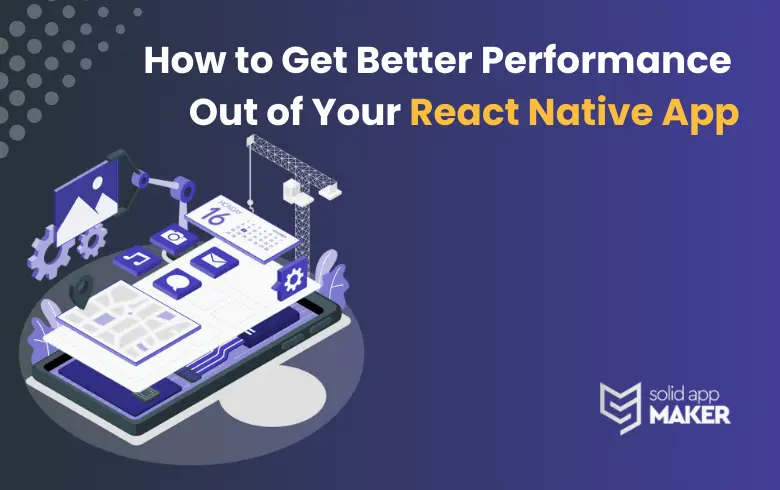In today’s world, where mobile app users expect fast, responsive, and efficient experiences, optimizing the performance of your React Native app is crucial. If you serve react app development services to myriad clients, this article will help you dive into strategies to enhance your app’s performance. Let’s take your React Native app to the next level.
What Affects React Native App Performance?
React Native relies on JavaScript to drive your app, and while JavaScript is versatile, it can also be a performance bottleneck. The single-threaded nature of JavaScript means heavy computation and rendering can make your app appear slow or unresponsive.
The bridge, responsible for communication between JavaScript and Native modules, can introduce latency as data gets serialized and deserialized. Additionally, rendering components can be resource-intensive, affecting your app’s speed.
Measuring Performance
The first step to enhancing your React Native app’s performance is understanding its current state. You can use performance analysis tools that reveal performance bottlenecks. Key metrics to monitor include frame rate, CPU usage, and memory consumption.
Optimizing React Native Performance
Reduce JavaScript Work
Optimize Renders: React components re-render when their state or props change. To avoid unnecessary re-renders, use methods like shouldComponentUpdate or React.memo. These tools help you manage when components should update, which can significantly enhance performance.
Lazy Loading: Loading all components and resources during app startup can slow down your app’s initial load time. Employ lazy loading to load components and resources only when they’re needed, reducing the initial bundle size and improving load times.
Bundling and Code Splitting: Utilize advanced bundling techniques and code splitting to reduce the size of your JavaScript bundle. Smaller bundles load faster, resulting in better app performance. Remember, an optimized bundle is a fast bundle.
Improve Bridge Communication
Use Native Modules: Offload computation-heavy or processing tasks to Native modules, as they can run on separate threads without blocking the JavaScript thread. This parallelism can lead to a significant boost in-app responsiveness.
Batch Bridge Calls: Minimize the number of bridge calls by batching them when possible. Reducing the frequency of communication between JavaScript and Native modules can lead to performance improvements. By grouping related calls, you can use the bridge more efficiently.
Efficient Rendering
Virtualized Lists: When working with long lists, utilize components like FlatList or SectionList. These components efficiently render long lists by rendering only the visible items on the screen. This optimized rendering strategy can significantly improve the scrolling performance of your app.
Leverage InteractionManager: Prioritize animations and interactions using the InteractionManager. By doing so, animations and interactions remain smooth and responsive, ensuring a better user experience. Smoother interactions lead to happier users.
Testing and Debugging
Testing and debugging are essential to ensure your app performs well in real-world scenarios.
Real-World Testing
Test on Actual Devices: Emulators and simulators might not accurately reflect real performance. Testing on real devices helps uncover device-specific performance issues, ensuring your app is optimized for your users’ devices.
User Testing: Gathering feedback from real users can highlight performance issues that may have been missed during development. Real user experiences provide invaluable insights into your app’s actual performance in the hands of your target audience.
Profiling and Debugging
React Native Debugger: Use tools like the React Native Debugger for profiling your app’s performance. Profiling identifies performance bottlenecks, assisting you in optimization. Detailed profiling results can be your roadmap to performance enhancements.
Debugging Slow Components: React DevTools helps identify and rectify slow components. It allows you to pinpoint which components are causing performance issues and to focus your optimization efforts where they are needed the most.
Over To You
In every application, performance is a defining factor in attracting and retaining users. By understanding the elements that influence React Native app performance and implementing optimization strategies, you can provide your users with a faster and smoother app experience. It’s important to remember that performance optimization is an ongoing process. Regularly monitor and improve your app’s performance to remain at the forefront of the mobile app landscape.
Get Premium React Native App Development Services
Here at Solid App Maker, we offer top-notch React Native app development services to help you build high-performance, engaging mobile applications. If you’re looking to create an app that not only meets but exceeds your performance expectations, our team of experienced developers is here to assist you every step. Contact us today to learn more about how we can turn your app vision into a fast, responsive, and efficient reality.

